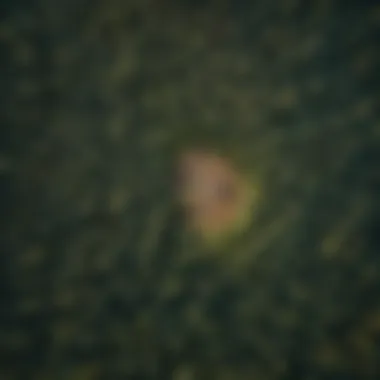Exploring Aerial Innovations in Forestry Management


Intro
This article will thoroughly examine the role of sky services in forestry. Understanding how aerial technologies can enhance forest management is crucial today. We will look at several critical aspects, including remote sensing, drone applications, and satellite imagery. Each of these technologies contributes significantly to better decision-making in woodland management and ecosystem health.
The rising demand for sustainable forestry practices compels professionals to adopt innovative solutions. There is a need for adaptive methods that prioritize the health of the ecosystem while allowing for resource management. This exploration will offer insights into these technologies and their practical applications, focusing on their influence on biodiversity and relationship with sustainable practices.
Overview of Forestry Practices
Definition of Forestry
Forestry encompasses the management and cultivation of forests, including trees, wildlife, and associated resources. It emphasizes sustainable practices that ensure the health of forest ecosystems. Inspection and management using aerial technologies can enhance traditional forestry methods. It allows for comprehensive monitoring of forest health, tracking changes over time, and assessing the impacts of land use.
Forestry is not just about trees but also involves understanding the complex interactions between various elements in an ecosystem, including soil, water, and wildlife.
Importance of Forestry in Ecosystem Management
Forests play a vital role in maintaining ecological balance. They act as carbon sinks, help in regulating water cycles, and provide habitats for diverse species. Effective forestry practices contribute to improved biodiversity, soil preservation, and climate regulation. The integration of sky services helps in achieving these goals more efficiently.
With aerial perspectives, it becomes easier to identify areas of concern, such as disease outbreaks in trees or the impact of invasive species. This proactive approach enhances forest resilience against potential threats.
Sustainable Forest Management
Principles of Sustainable Practices
Sustainable forest management is a systematic approach designed to maintain the ecological, economic, and social functions of forests. The principles include:
- Inter-generational equity: Ensuring that forest resources are available for future generations.
- Biodiversity conservation: Protecting various species and habitats within forests.
- Forest productivity: Enhancing forest growth and regeneration to meet current and future wood needs.
These principles guide forestry professionals in making informed decisions that benefit both the environment and the community.
Techniques in Sustainable Management
Implementing sustainable management strategies often involves the use of advanced aerial technologies. For instance, remote sensing allows for the quick assessment of forest cover, enabling timely responses to ecological disturbances. Drones provide precise data on tree health and growth patterns.
Forest managers can also utilize satellite imagery for large-scale monitoring, which helps understand land use changes and their impacts. This continuous data collection aids in making sound management decisions grounded in science.
Woodland Stewardship Strategies
Importance of Woodland Stewardship
Woodland stewardship emphasizes the active management of forest ecosystems. By adopting stewardship principles, landowners can promote ecological health, enhance recreational opportunities, and support local economies. Good stewardship practices contribute to the long-term sustainability of forests.
Best Practices for Landowners
Landowners can implement various strategies to manage their woodlands effectively:
- Regular forest assessments using aerial technologies.
- Engaging in restoration projects for damaged areas.
- Participating in community forestry initiatives to share knowledge.
Incorporating aerial monitoring enhances these efforts, ensuring that landowners are equipped with the data needed to optimize forest health and productivity.
"Informed decisions are crucial for the sustainability of forest ecosystems. Aerial technologies provide valuable insights that aid in achieving this goal."
Understanding the role of sky services in forestry is essential for current and future practices. By leveraging aerial technologies, forestry professionals can better manage resources, making informed decisions aimed at long-term sustainability.
Preamble to Sky Services
Sky services represent a paradigm shift in the way forestry is managed and understood. This section sets the foundation for discussing the rest of the article. Sky services encompass various technologies that leverage aerial data collection and analysis to enhance forestry practices. By analyzing these services, professionals can now monitor forests more effectively and make informed decisions that are critical for sustainability.
Definition and Scope
Sky services include techniques such as remote sensing, aerial imagery, and drone technology. These methods collect data from aerial perspectives, providing insights that are not easily obtainable from ground-level assessments. The scope of sky services is broad, covering various aspects of forestry, such as health assessments, resource management, and climate impact evaluations.
This approach is essential for understanding the complex dynamics of forest ecosystems. The data gathered is instrumental in identifying trends, assessing environmental changes, and planning conservation efforts.


Importance in Forestry
The importance of sky services in forestry cannot be overstated. These services improve the accuracy of forest data collection, which is vital for decision making. Better data leads to more effective strategies for managing resources and preserving biodiversity.
- Enhanced Monitoring: Sky services allow for continuous monitoring, enabling foresters to detect changes in tree health and growth patterns.
- Informed Decision Making: With clearer insights, stakeholders can make data-driven decisions regarding land use and conservation efforts.
- Cost Efficiency: By collecting comprehensive aerial data, unnecessary ground surveys can be minimized, reducing both time and costs in forest management.
"The integration of sky services into forestry practices significantly boosts operational efficiency and informs sustainable management strategies."
In summary, the introduction of sky services transforms forestry management. Better tools and perspectives lead to improved outcomes for forests and their ecosystems.
Technological Advancements in Sky Services
The realm of forestry has always relied on innovative methods to monitor and manage resources effectively. In this context, technological advancements in sky services play an essential role. These tools offer precise, comprehensive data that can enhance the quality of timber management, conservation efforts, and ecological assessment. The technologies explored in this section include remote sensing, drone applications, and satellite imagery, each providing unique advantages for forestry professionals.
Remote Sensing Technologies
Remote sensing technology involves collecting data about the earth's surface without direct contact. This method facilitates broad-scale observation of forests, making it possible to identify trends and problems from a distance. Common remote sensing technologies used in forestry include LiDAR and multispectral imaging.
- LiDAR: This method uses laser light to measure distances accurately and create high-resolution models of terrain and vegetation. It can detail forest structure, estimating tree height and density effectively.
- Multispectral Imaging: Multispectral sensors capture light in various wavelengths, allowing for detailed vegetation analysis. This helps in assessing plant health, determining species composition, and monitoring changes over time.
By implementing remote sensing, forestry experts can gather extensive data across large areas efficiently. These insights support better decision-making for resource allocation and land management. Moreover, the ability to monitor forest dynamics over time contributes significantly to sustainable practices.
Drone Applications
Drones have rapidly become an indispensable tool in forestry management. Their capability to reach remote or hazardous locations without risk to human operators marks a significant improvement. Drones are equipped with advanced cameras and sensors that can provide real-time data.
Some key advantages of using drones in forestry include:
- Accessing Hard-to-Reach Areas: Drones can fly over dense forests and cliffs that may hinder ground access. This feature allows for thorough inspections and assessments.
- Cost-Effectiveness: Utilizing drones can lower operational expenses associated with ground surveys, making aerial monitoring more economical.
- Rapid Data Collection: Drones can gather data quickly and frequently, enabling timely assessments of forest health and resource conditions.
Operations such as tree inventory, health assessments, and damage evaluations can be conducted efficiently, ensuring that professionals stay updated with the current state of their resources.
Satellite Imagery Utilization
Satellite imagery serves as a powerful tool for long-term forest monitoring. Satellites provide a broader perspective, enabling observations over vast landscapes with minimal temporal delays. The data derived from satellites can cover extensive geographical areas, thus offering a landscape-level view of forestry conditions.
The advantages of satellite imagery include:
- High Spatial Resolution: Modern satellites capture detailed images, allowing for precise analysis of forest cover and changes.
- Temporal Frequency: Frequent satellite passes mean that updates on forest conditions can be obtained regularly, which is crucial for responding to environmental changes swiftly.
- Global Coverage: Satellites can cover forests in remote locations across the globe, making them vital for both local and international forestry assessments.
Integrating satellite data into forestry management systems provides a comprehensive understanding of regional ecological dynamics. This approach fosters improved conservation efforts and better-informed policy decisions.
"Understanding the technological landscape of sky services is vital for advancing sustainable forestry practices. By leveraging remote sensing, drone technology, and satellite imagery, professionals can achieve remarkable insights into forest health and management."
In summary, the advancements in sky services technology offer forestry professionals new capabilities and insights. These innovations present opportunities for enhanced data collection, improved decision-making, and more effective resource management.
Applications of Sky Services in Forestry
Sky services have become essential tools in modern forestry. These applications utilize aerial data to aid in the management and sustainability of forest ecosystems. They bring significant value to the industry by facilitating informed decision-making and improving operational efficiency. With the ongoing demands for sustainable practices, understanding the applications of sky services is vital for forestry professionals.
Forest Health Monitoring
Forest health monitoring is a critical application of sky services. It involves the continuous assessment of forest conditions to detect problems before they escalate. Remote sensing technologies allow for the gathering of crucial data on vegetation health, pest infestations, and fire risks.
By integrating tools like drones and satellite imagery, forestry managers can analyze tree color, leaf vitality, and canopy density. These assessments enable quick responses to threats, which is crucial in maintaining ecosystem balance. Also, using these technologies helps identify areas needing intervention, whether through restoration efforts or targeted treatments against diseases and pests.
Biodiversity Assessment
Biodiversity assessment through sky services plays a pivotal role in understanding and preserving forest ecosystems. The rich complexity of biodiversity in forests requires detailed analysis, which can be efficiently achieved using aerial imagery and drones. This approach allows for large area coverage and helps gather data on various species distribution and habitat conditions.
With this information, professionals can make informed decisions that enhance conservation efforts. Mapping and tracking changes in biodiversity also guide restoration projects by identifying keystone species and critical habitats. Moreover, assessments from above facilitate collaboration between stakeholders, ensuring that all parties are informed and can contribute to biodiversity enrichment strategies.
Resource Management


Effective resource management within forestry is essential for sustainability and operational efficiency. Sky services provide valuable insights into natural resource availability, such as timber and water resources. By utilizing high-resolution aerial data, forestry professionals can create detailed inventories of resources, monitor growth rates, and evaluate age structures of trees.
This data is crucial for planning harvesting schedules and minimizing waste. Furthermore, monitoring soil moisture levels through remote sensing aids in optimizing water management practices. This ensures that resources are utilized tactically, aligning with sustainable forestry principles. Incorporating sky services into resource management not only enhances productivity but also promotes long-term forest health and resilience.
Implementing sky services in forestry reshapes traditional practices. These technologies lead to proactive and informed management strategies.
In summary, the applications of sky services in forestry are diverse and impactful. From health monitoring to biodiversity assessments and effective resource management, these technologies contribute to sustainable forestry practices. Embracing these tools can enhance productivity, resilience, and conservation efforts in forest ecosystems.
Benefits of Implementing Sky Services
The integration of sky services into forestry practices presents various advantages that enhance both productivity and sustainability. These benefits are critical for forestry professionals aiming for effective resource management and improved ecosystem health. Emphasizing aerial techniques not only modernizes traditional forestry practices but also provides robust support for decision-making processes. Here, we will explore three key benefits: enhanced data collection, improved decision making, and cost-effectiveness.
Enhanced Data Collection
Sky services significantly improve the way data is collected in forestry. Traditional methods often rely on ground surveys, which can be time-consuming and sometimes inaccurate. Aerial technologies, such as drones and satellite imaging, allow for comprehensive data gathering over expansive areas within a short span of time. This rapid data collection ensures that forestry professionals have access to up-to-date information about forest health, terrain conditions, and resource availability.
These technologies excel in capturing various data types, including:
- Vegetation indices that assess plant health
- Topographical data for mapping land features
- Temperature and moisture readings that monitor environmental conditions
With such data, forest managers can create detailed reports that inform action plans. Furthermore, this data often includes visual imagery, which provides context that raw numbers may not convey. A strong grasp of this information is essential for insightful forestry practices.
Improved Decision Making
The information derived from sky services leads to enhanced decision-making capabilities. Having access to accurate and timely data allows forestry professionals to make informed choices concerning land management, conservation efforts, and resource allocation. When professionals base decisions on comprehensive data, outcomes tend to be more favorable.
For instance, data acquired through aerial assessments can help identify:
- Areas in need of reforestation
- Zones affected by pests or diseases
- Optimal harvesting times to minimize environmental impact
Incorporating real-time data analysis further streamlines this process. Technologies such as remote sensing can offer insights into changing conditions, enabling proactive management of resources and ecosystems. Ultimately, improved decision-making reduces the likelihood of costly mistakes and conserves valuable resources.
Cost-Effectiveness
Investing in sky services often leads to significant cost savings in the long run. While the initial implementation of technology might require capital, the operational efficiency gained through these tools can offset these costs rapidly.
- Reduced labor costs: Automated data collection via drones diminishes the need for extensive ground teams.
- Minimized resource wastage: Accurate assessments help prevent over-harvesting or under-utilization of forest resources.
- Enhanced monitoring: With ongoing aerial surveillance, issues can be detected early, averting larger expenditures on remediation efforts later.
Moreover, the precise information derived from these services allows for more strategic planning of forestry activities, which contributes to overall efficiency. The cost-effectiveness factor can be a compelling reason for forestry stakeholders to consider adopting aerial technologies in their practices.
The integration of sky services presents a forward-thinking approach, balancing operational efficiency with sustainability in forestry management.
Challenges in Sky Services
The utilization of sky services, particularly in forestry, faces several significant challenges that can affect their overall effectiveness and adoption. Understanding these challenges is crucial for forestry professionals and stakeholders as they look to implement and advance aerial technologies. The complexities inherent in data security, technical limitations, and regulatory compliance can hinder the expected benefits of these services.
Data Security and Privacy
As forestry services increasingly rely on aerial technologies, data security and privacy have become paramount. The collection of vast amounts of data—from tree health to forest composition—raises concerns about how this data is stored, accessed, and used. The risk of data breaches could expose sensitive information about forest locations, ownership, and management practices. This is particularly relevant in the context of private lands where confidentiality is a priority.
Additionally, the use of drones and satellites often requires substantial personal data. It is essential to know who controls this data and how it is protected. Advanced encryption methods and secure data transmission protocols have to be utilized to safeguard information from unauthorized access.
Forest managers must also navigate the legality surrounding data gathering. Engaging with local regulations that govern aerial surveillance practices can be complex. As such, forestry professionals should collaborate with cyber laws and data protection experts to ensure compliance.
Technical Limitations
Despite advancements in technology, technical limitations still plague sky services in forestry. Drones, while useful, have limitations in terms of battery life, payload capacity, and range. This can restrict the areas they can cover and the duration of their operations. Furthermore, the reliability of drone images during adverse weather conditions is a concern. Cloudy or rainy days can inhibit the ability to capture clear footage, which can limit data quality.
Satellites provide a broader view but come with their own sets of limitations. The resolution of satellite imagery can sometimes hinder the analysis of forest health at a micro level. High-resolution images may not be frequently available, meaning that timely data may not always be accessible.
Additionally, the integration of data from different sources, such as drones and satellite imagery, requires sophisticated software. The tools for analysis need to be robust to handle diverse data sets and provide meaningful insights. Inability to manage or analyze this data effectively impedes the full realization of sky services in forestry.
Regulatory Compliance


Regulatory compliance presents another layer of challenges. Different countries and regions have varying laws governing the use of aerial technologies. Understanding and complying with these regulations can be arduous. For example, drone operations often require specific licenses, and flight paths may be restricted over certain areas, such as national parks or populated regions.
Monitoring compliance with regulations can be resource-intensive for forestry managers. Failure to comply can lead to hefty fines and impede ongoing projects. This situation stresses the importance of staying updated on regulatory changes that could impact aerial forestry operations.
In summary, addressing these challenges—data security and privacy, technical limitations, and regulatory compliance—is crucial for successful implementation of sky services in forestry. Through careful planning and collaboration, forestry professionals can better navigate these obstacles, facilitating the effective use of aerial technologies in woodland management.
Case Studies of Sky Services in Action
Case studies provide significant insights into the practical applications of sky services in forestry. They showcase how these services have been implemented in real-world scenarios, highlighting both their success and the challenges encountered. The value of case studies lies in their ability to translate theoretical concepts into actionable knowledge, making them essential for both practitioners and researchers in forestry.
Successful Implementations
The success of sky services can be seen in various instances across the globe. For example, the implementation of drone technology in Canada has transformed forest fire surveillance. Drones equipped with thermal imaging cameras allow for real-time monitoring of forest conditions. This capability not only enhances detection but also reduces response time in emergencies. This has been especially crucial in regions prone to wildfires.
Another notable case comes from Norway, where satellite imagery is utilized to monitor reforestation efforts. By analyzing changes in land use over time, forestry managers can adapt their strategies based on growth patterns. The use of high-resolution satellite images enables precise assessments of plant health and density. This has proven to be effective in optimizing resource allocation.
Furthermore, in Australia, a collaborative project used remote sensing technologies to evaluate biodiversity in forested regions. The project aimed to assess habitat quality by analyzing canopy cover and tree species diversity. Such data is crucial for conservation strategies and can guide future planting efforts.
Lessons Learned
Despite the successes, there are important lessons that have emerged from these case studies. One critical takeaway is the need for training and capacity building among forest managers. Many practitioners may lack the technical skills required to interpret complex data from drones or satellites. Ongoing education ensures that they can effectively utilize this technology and make informed decisions.
Moreover, integration of these technologies into existing management practices is often underestimated. Some projects have struggled due to a lack of coordination between traditional practices and new innovations. Strategies must be created to bridge this gap for optimal results.
Lastly, data privacy and security remain a primary concern. As remote sensing technologies collect vast amounts of information about forest areas, ensuring that this data is protected from misuse is imperative. Establishing clear guidelines while respecting privacy rights is essential for gaining public trust and ensuring project longevity.
"Effective implementation of sky services not only enhances operational efficiency but also fosters a culture of innovation and adaptability in forestry management."
These case studies illustrate both the potential and challenges of sky services in forestry. Understanding their impact provides a more robust framework for integrating these technologies into future practices.
Future Trends in Sky Services for Forestry
The landscape of forestry is on the brink of profound transformation owing to ever-evolving sky services. Understanding these trends is vital for forestry professionals looking to adapt their strategies and practices in response to changing technological and environmental conditions. The integration of emerging technologies and sustainability initiatives will not only enhance efficiency but also align with global ecological goals.
Emerging Technologies
One notable trend is the rise of advanced aerial technologies. Drones, equipped with sophisticated sensors, are advancing rapidly. They offer high-resolution imagery, aiding in real-time forest monitoring. These drones can capture detailed data on tree health and forest coverage.
Key benefits of emerging technologies include:
- High Precision: High levels of accuracy in data collection.
- Time Efficiency: Drones reduce the time needed for traditional surveys, delivering faster results.
- Cost-Effectiveness: Lower operational costs than manned aerial surveys.
Recent advancements also involve combining drone technology with artificial intelligence (AI). AI algorithms can analyze immense datasets, facilitating better decision-making regarding timber management or pest control. Also, satellite technologies, such as PlanetScope, allow for regular monitoring of vast forest areas—often cloud-free—enhancing the frequency and reliability of updates.
Sustainability Initiatives
Sustainability initiatives play a crucial role in the future of sky services in forestry. These initiatives aim to utilize aerial data to support conservation efforts and promote sustainable practices. For instance, ecosystem restoration projects increasingly depend on aerial imagery to assess land degradation and monitor recovery progress.
Here are several key sustainability initiatives:
- Carbon Footprint Monitoring: Utilizing aerial data to monitor forests' carbon sequestration capabilities.
- Wildlife Habitat Assessment: Assessing changes in biodiversity using aerial surveys helps tailor conservation efforts.
- Sustainable Logging Practices: Implementing aerial monitoring to ensure logging practices do not exceed ecological thresholds.
In connection with the motivations for these initiatives, external stakeholders are gaining interest. Governments, NGOs, and research organizations collaborate to foster environmental advocacy and promote sustainable practices. Overall, the focus is shifting towards using data from aerial services as a critical element in preserving forest resources and ecosystem health.
"Emerging technologies and sustainability efforts will shape the future of forest management, ensuring the long-term health of our ecosystems."
The End
In summary, the exploration of sky services within forestry reveals its critical role in modern woodland management and ecosystem preservation. The integration of aerial technologies such as drones, satellite imagery, and remote sensing enhances the capacity for effective decision-making. This is particularly relevant considering the challenges faced in monitoring forest health and biodiversity.
Recap of Key Points
- Importance of Aerial Data: Aerial monitoring provides an unprecedented view of forest conditions, allowing for more accurate assessments and real-time data collection.
- Benefits of Technology Implementation: Enhanced data collection techniques lead to better strategies in resource management and biodiversity conservation.
- Identified Challenges: Issues regarding data security, technical limitations, and compliance with regulations remain pivotal for successful implementation of these technologies.
The Future of Forestry with Sky Services
As we look ahead, the potential of sky services in forestry continues to grow. Emerging technologies promise to further improve the efficiency of forest management practices. Innovations in data analysis, combined with a stronger focus on sustainability, create new avenues for forest stewardship.
The future also points toward greater collaboration between technology providers and forestry professionals. This is crucial for developing tailored solutions that enhance ecosystem health while also considering economic factors. Continuous research and development in sky services will drive improvements and foster sustainable practices that benefit both nature and communities.
"The evolution of forestry through sky services marks a paradigm shift. The blend of technology and ecology holds the key to a sustainable future."







